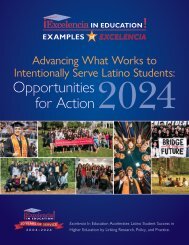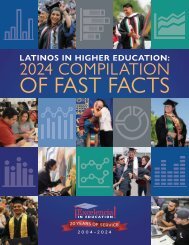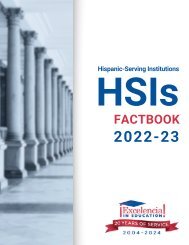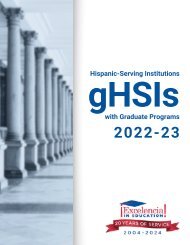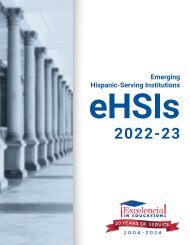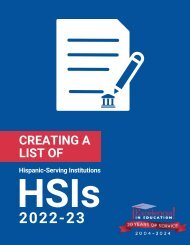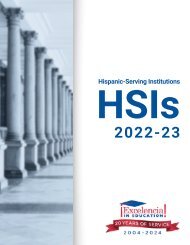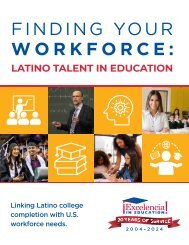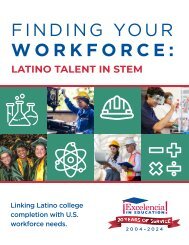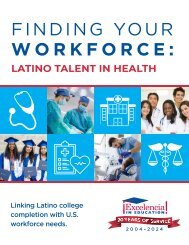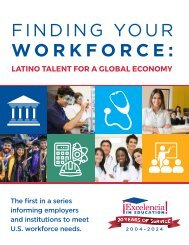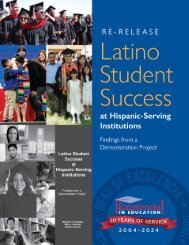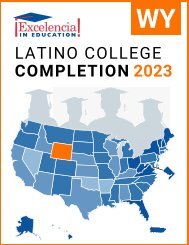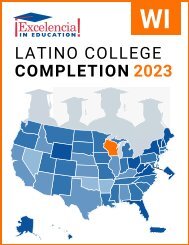Latino College Completion 2023: Colorado
You also want an ePaper? Increase the reach of your titles
YUMPU automatically turns print PDFs into web optimized ePapers that Google loves.
CO
LATINO COLLEGE COMPLETION:<br />
COLORADO – <strong>2023</strong><br />
For the U.S. to regain the top ranking in the world for college degree<br />
attainment, <strong>Latino</strong>s will need to earn 6.2 million degrees by 2030. 1<br />
FAST FACTS<br />
STATE RANKING:<br />
<strong>Colorado</strong> had the 8th largest<br />
<strong>Latino</strong> population in the U.S.<br />
K-12 POPULATION:<br />
In <strong>Colorado</strong>, 31% of the K-12<br />
population was <strong>Latino</strong>. 2<br />
POPULATION:<br />
In <strong>Colorado</strong>, 22% of the population<br />
was <strong>Latino</strong>. 2<br />
MEDIAN AGE:<br />
The median age<br />
of Hispanics<br />
in <strong>Colorado</strong> was<br />
29, compared<br />
to 41 for White<br />
non-Hispanics. 2<br />
29<br />
Hispanics<br />
41<br />
White<br />
non-Hispanics<br />
ENROLLMENT:<br />
In <strong>Colorado</strong>, 18% of Hispanics<br />
(ages 18 to 34) were enrolled in<br />
higher education, compared to<br />
21% of White non-Hispanics. 2<br />
DEGREE ATTAINMENT:<br />
In <strong>Colorado</strong>, 28% of Hispanic<br />
adults (25 and older) had earned an<br />
associate degree or higher, compared to<br />
59% of White non-Hispanic adults. 2<br />
Hispanic Adults = 2.8 of 10<br />
To reach the degree attainment goal by 2030, the U.S. can: close<br />
the degree completion gap by accelerating <strong>Latino</strong> completion while<br />
increasing for all students and scale up programs and initiatives that<br />
work for <strong>Latino</strong>, and all, students. The following demographics,<br />
institutional data, and practices inform <strong>Latino</strong> degree attainment.<br />
ENROLLING: Top 5 Institutions (Hispanic Undergraduates) in <strong>Colorado</strong>, 2021-22<br />
Institution<br />
Sector<br />
Grand<br />
Total<br />
NOTE: We use the terms <strong>Latino</strong> and Hispanic interchangeably in this factsheet.<br />
Hispanic<br />
Total<br />
Source: Excelencia in Education analysis using U.S. Department of Education, National Center for<br />
Education Statistics (NCES), Integrated Postsecondary Education Data System (IPEDS), 2021 Fall<br />
Enrollment, Graduation Rates Survey and Institutional Characteristics Survey.<br />
%<br />
Hispanic<br />
1 Metropolitan State University of Denver Public, 4-year 15,625 5,198 33%<br />
2 University of <strong>Colorado</strong> Boulder Public, 4-year 30,414 4,042 13%<br />
3 <strong>Colorado</strong> State University-Fort Collins Public, 4-year 24,344 3,727 15%<br />
University of <strong>Colorado</strong> Denver/Anschutz<br />
4 Medical Campus<br />
Public, 4-year 11,042 2,799 25%<br />
5 Front Range Community <strong>College</strong> Public, 4-year 11,436 2,795 24%<br />
ASSOCIATE DEGREES: Top 5 Institutions Awarding to Hispanics in <strong>Colorado</strong>, 2020-21<br />
Institution<br />
Sector<br />
Grand<br />
Total<br />
Hispanic<br />
Total<br />
%<br />
Hispanic<br />
1 Front Range Community <strong>College</strong> Public, 4-year 1,831 337 18%<br />
2 Pikes Peak Community <strong>College</strong> Public, 4-year 1,665 318 19%<br />
3 Aims Community <strong>College</strong> Public, 2-year 660 222 34%<br />
4 Community <strong>College</strong> of Denver Public, 4-year 715 216 30%<br />
5 Pueblo Community <strong>College</strong> Public, 4-year 723 213 29%<br />
BACHELOR DEGREES: Top 5 Institutions Awarding to Hispanics in <strong>Colorado</strong>, 2020-21<br />
Institution<br />
Sector<br />
Grand<br />
Total<br />
Hispanic<br />
Total<br />
%<br />
Hispanic<br />
1 University of <strong>Colorado</strong> Boulder Public, 4-year 6,753 840 12%<br />
2 Metropolitan State University of Denver Public, 4-year 3,100 791 26%<br />
3 <strong>Colorado</strong> State University-Fort Collins Public, 4-year 5,195 745 14%<br />
University of <strong>Colorado</strong> Denver/Anschutz<br />
4 Medical Campus<br />
Public, 4-year 2,786 571 20%<br />
5 University of Northern <strong>Colorado</strong> Public, 4-year 1,945 393 20%<br />
White Adults = 5.9 of 10<br />
1 Projections to 2030: Excelencia in Education. (2020). Ensuring America’s Future: Benchmarking <strong>Latino</strong><br />
<strong>College</strong> <strong>Completion</strong> to 2030. Excelencia in Education. Washington, D.C.<br />
2 U.S. Census Bureau, 2021 American Community Survey 1-Year Estimates
<strong>Colorado</strong> Gap in Degree <strong>Completion</strong><br />
Closing the degree completion gap can be tracked<br />
by the 4 measures shown below. Alone, none<br />
of these measures capture the entire “story” of<br />
degree completion. However, in combination,<br />
they provide a useful picture of the gap in degree<br />
attainment between Hispanic and White non-<br />
Hispanic cohorts in a single year.<br />
Graduation Rate — Total percentage of students<br />
who graduated within 150% of normal time for<br />
first-time, full-time freshmen. This incorporates<br />
students that graduated in 3 years at two-year<br />
institutions, or in 6 years at four-year institutions.<br />
Transferred to Another Institution —<br />
Percentage of students that transferred to another<br />
institution and did not complete a degree.<br />
Still Enrolled — Percentage of students that are<br />
still enrolled at the point of 150% normal time to<br />
completion.<br />
No Longer Enrolled — Percentage of students<br />
that are no longer enrolled at the point of 150%<br />
normal time to completion.<br />
At two-year institutions, Hispanics’<br />
graduation rate was 3%-points<br />
lower than that of their White<br />
non-Hispanic peers in <strong>Colorado</strong>.<br />
TWO-YEAR INSTITUTIONS<br />
2%<br />
35%<br />
6%<br />
57%<br />
WHITE<br />
-3%<br />
37%<br />
4%<br />
5%<br />
54%<br />
HISPANIC<br />
DEGREE OUTCOMES<br />
■ No Longer Enrolled<br />
■ Still Enrolled<br />
■ Transferred to<br />
Another Institution<br />
■ Graduation Rate<br />
*Percentages may not add up to 100% due to rounding.<br />
At four-year institutions, Hispanics’<br />
graduation rate was 15%-points<br />
lower than that of their White<br />
non-Hispanic peers in <strong>Colorado</strong>.<br />
FOUR-YEAR INSTITUTIONS<br />
3%<br />
21% 30%<br />
17%<br />
59%<br />
WHITE<br />
-15%<br />
4%<br />
22%<br />
44%<br />
HISPANIC<br />
NOTE: Outcomes shown are for students at two-year institutions who started in Fall 2018, and<br />
for students at four-year institutions who started in Fall 2015.<br />
Source: Excelencia in Education analysis using the U.S. Department of Education, National<br />
Center for Education Statistics (NCES), Integrated Postsecondary Education Data System, 2021<br />
Graduation Rates Survey and the Institutional Characteristics Survey.<br />
Examples of What Works for <strong>Latino</strong> Students<br />
There are institutions showing success in enrolling, retaining, and graduating <strong>Latino</strong> students. The following are examples of<br />
programs across the country with evidence of effectiveness in serving <strong>Latino</strong> students nominated for Examples of Excelencia.<br />
The CUMBRES Teacher Preparation Program at University of<br />
Northern <strong>Colorado</strong> (UNC) is a scholarship and support program for<br />
students who are planning to become English as a Second Language<br />
(ESL) teachers. Cumbres recruits, supports, and mentors undergraduate<br />
students who pursue a degree in education and who also declare an<br />
endorsement in English as a Second Language (ESL) to work and teach<br />
culturally and linguistically diverse students in K-12 education. Students<br />
are offered scholarships to ensure persistence in the program. Cumbres<br />
is grounded in three high-impact educational practices designed to<br />
bridge the service gaps for Latinx and all program participants: (1)<br />
Residential Community — During their freshman year, participants live<br />
in a residential community. An upper-classman Resident Assistant (RA)<br />
who is also a Cumbres student serves as a mentor and tutor to students<br />
to provide meaningful, ongoing support; (2) Learning Community — As<br />
part of their general education requirements, participants take classes<br />
together with their Cumbres cohort. This allows students to be in<br />
classes with their residential community to build a community that<br />
supports each other academically and socially; and, (3) Mentorship: Firstyear<br />
participants (including transfer and non-traditional students) meet<br />
with a peer academic advisor and a mentor teacher in K-12 education.<br />
<strong>Latino</strong>s represent 40% of Cumbres Teacher preparation program<br />
participants, significantly higher than the institution’s overall <strong>Latino</strong><br />
enrollment rate. As of July 2017, 328 students have graduated from the<br />
Cumbres program, 56% of them identifying as <strong>Latino</strong>. In 2020, 61%<br />
(14 of 23) of participants who began the program in the 2014 cohort<br />
graduated within six years. In comparison, 50% of all students at UNC<br />
graduate within six years. Each year, approximately 90% of participants<br />
secure ESL teaching positions in K-12 either prior to graduation or<br />
before the start of the next K-12 school year or term.<br />
For more information on institutional programs improving <strong>Latino</strong> student success in higher education, access Excelencia in<br />
Education’s Growing What Works database at http://www.edexcelencia.org/growing-what-works<br />
ENSURING AMERICA’S FUTURE BY INCREASING LATINO COLLEGE COMPLETION • WWW.EDEXCELENCIA.ORG




